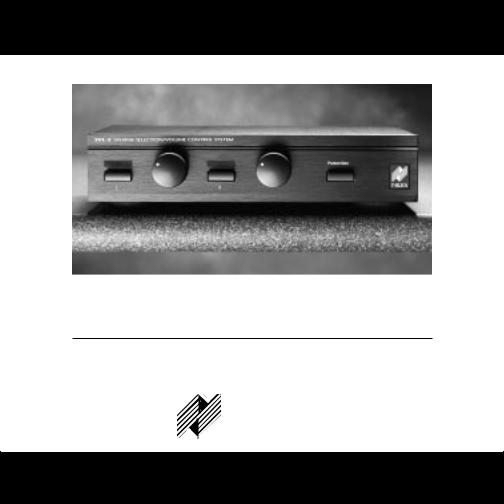Niles Audio SVL-2 User Manual

M O D E L
SVL-2
SVL-2
SPEAKER SELECTION/VOLUME CONTROL SYSTEM
®
I N S T A L L A T I O N & O P E R A T I O N G U I D E

S P E A K E R S E L E C T I O N / V O L U M E C O N T R O L S Y S T E M
SVL-2
Speaker Selection/
Volume Control
System
TABLE OF CONTENTS |
Introduction |
||
Introduction |
1 |
The SVL-2 is a combination speaker selector and volume con- |
|
troller. It allows you to connect two pairs of speakers to your |
|||
|
|
||
Features and |
|
stereo receiver or amplifier and adjust the volume of each |
|
Benefits |
2 |
pair independently. Additionally, you can choose to listen to |
|
|
|
either pair of speakers, or both pairs simultaneously. You |
|
Installation |
|
don't have to worry about overloading your amplifier. The |
|
Considerations 4 |
SVL-2 has a protection circuit that keeps your amplifier run- |
||
Installation |
8 |
ning safely, even with both pairs of speakers playing. |
|
|
|||
Operation |
10 |
A perfect application for the SVL-2 is individually controlling |
|
speaker "ON/OFF" and volume adjustment for two pairs of |
|||
Specifications |
14 |
speakers: one pair in the room with the main stereo system |
|
and another pair at a remote location. The SVL-2 adjusts the |
|||
|
|
volume of the speakers connected to it by attenuating the |
|
|
|
amplifier signal. Niles volume controls use autoformers |
|
|
|
instead of L-pads for the volume controlling element. This |
|
|
|
assures minimal internal power dissipation with virtually no |
|
|
|
power wasted as heat. |
|
1

S P E A K E R S E L E C T I O N / V O L U M E C O N T R O L S Y S T E M
Features and Benefits
The SVL-2 offers a number of improvements over other speaker selector/volume controllers:
●The SVL-2 uses 12 position volume controls which are superior to 10 position designs. You get a broader range of adjustment—there are 10 steps of attenuation instead of 8. Steps 11-6 attenuate -3 dB per step; steps 5-2 are 6 dB per step. Step 12 is "full-on" and step 1 is "full-off".
●Greater dynamic range—you get 42 dB of total attenuation instead of the usual 20 or 30 dB.
●POP-FREE switching between all steps.
●Pre-printed Room Labels are included for easy identification of speaker ON/OFF buttons.
●Isolated right and left channel ground returns make the SVL-2 compatible with all types of amplifiers.
●Self-cleaning, silver-plated switch contacts assure many years of trouble free use.
●Printed circuit board design assures high reliability.
TECH
SUPPORT
HOTLINE
If you have questions regarding the operation of the Niles SVL-2, contact your local Niles dealer or Niles Customer Service at 1-800-289-4434.
2

S P E A K E R S E L E C T I O N / V O L U M E C O N T R O L S Y S T E M
●Spring-loaded push terminal connectors accommodate up to 14 gauge wire or "pins", making the SVL-2 compatible with most "high-definition" speaker cables.
●100% tested, electronically and acoustically, for frequency response, distortion and power handling.
●Only 8 1/2" wide. Match the width of 17" components by combining with another Niles 1/2 width product.
●May be used with 4, 6 or 8-ohm speaker systems.
●Ideal for both home and commercial sound installations.
●Only a wire stripper is required for installation.
●Power handling: 100 watts/channel continuous music power.
●Frequency response: 20 Hz to 20 kHz +/-1.2 dB.
●Ten year parts and labor warranty.
●Proudly made in the USA.
3

S P E A K E R S E L E C T I O N / V O L U M E C O N T R O L S Y S T E M
Installation Considerations
SVL-2 Power Handling
The SVL-2 is designed for use with a receiver or amplifier having a maximum power output of 100 watts per channel at 8 ohms. Damage caused by the use of a higher-power receiver or amplifier will void the warranty. Consult your Niles dealer, or receiver/amplifier manufacturer, if you are uncertain about the power rating of your receiver or amplifier.
IMPORTANT: DO NOT USE THE SVL-2 WITH AMPS OR RECEIVERS RATED AT MORE THAN 100 WATTS PER CHANNEL RMS AT 8 OHMS.
Amplifier Impedance Load
As more pairs of speakers are parallel connected to a receiver or amplifier, the overall system impedance becomes lower. For example, if two pairs of 8-ohm speakers are connected in parallel, the impedance will be 4 ohms, two pairs of 4-ohm speakers in parallel become 2 ohms, and so on.
Most receivers or amplifiers are not rated for use below a 4 ohm load. Most manufacturers do not recommend connecting two pairs of 4-ohm speakers without using some form of impedance correction.
TOOLS
REQUIRED
• Wire Stripper
4
